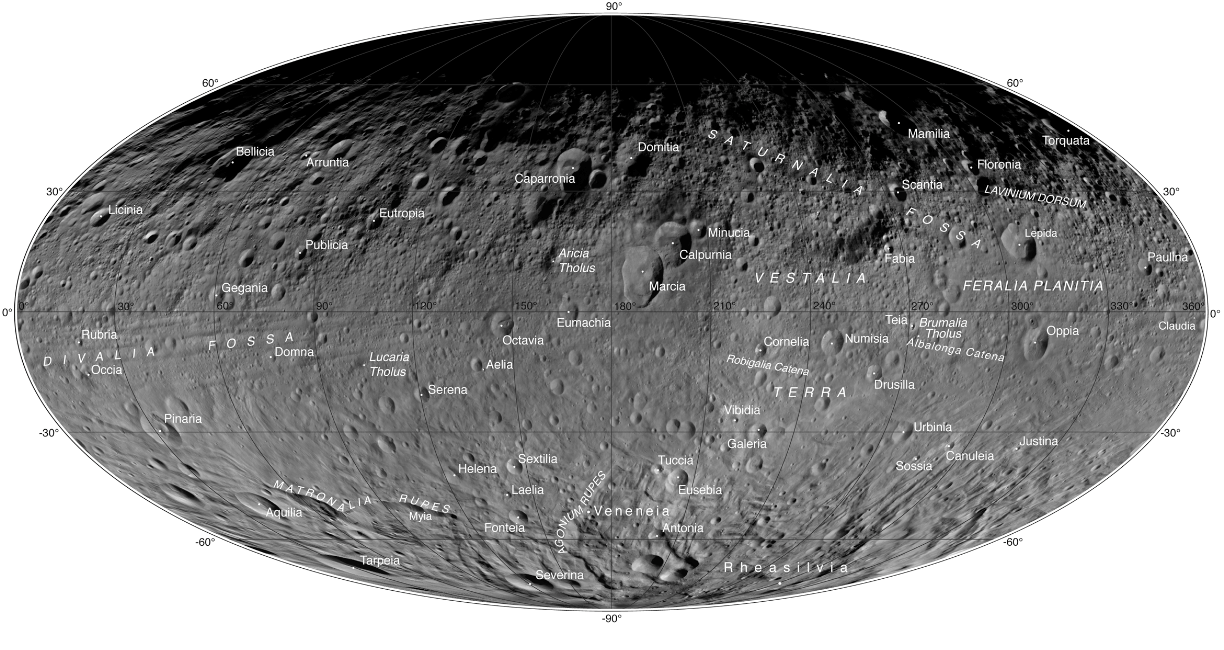
Are you curious about what an asteroid would look like if you could visit it up close and personal? Despite what we see in movies, asteroids are real curiosities and examining one of the largest has been the goal of the Dawn spacecraft. Orbiting asteroid Ceres for more than a year, the mission has taken over 10,000 images during its Low Altitude Mapping Orbit (LAMO).
These high-resolution images were then assembled into a virtual atlas which has now become available for the public to explore. Like a terrestrial road map, these mosaics are mostly at a scale of 1:200 0000 (1 centimeter = 2 kilometers) and reveal the surface of this distant space rock in incredible detail.
"Creating the atlas has been a painstaking task - each map sheet of this series has used about 400 images," said Dr. Thomas Roatsch. "The atlas shows how extreme the terrain is on such a small body as Vesta. In the south pole projection alone, the Severina crater contours reach a depth of 18 kilometers; just over a hundred kilometers away the mountain peak towers 7 kilometers above the ellipsoid reference level."
If you like examining images for minute details, then you'll love looking at Vesta. The atlas consists of 29 separate maps taken from three different projections: Mercator for equatorial regions, Lambert conical projections for mid-latitudes and a stereographic projection for the Rheasilvia basin at Vesta's southern pole.
Like all orbiting bodies, asteroid Vesta has "seasons," and the LAMO mapping project encompassed Vesta's northern winter - a time when its north pole was in complete darkness. The atlas is so complete that it even includes some lower resolution images taken during the High Altitude Mapping Orbit (HAMO), just to be sure that every square meter of the asteroid was covered.
However, the information doesn't stop there. Not only does the atlas include high-resolution map tiles, it also includes an index map, a perspective view and a color-coded and shaded relief map. The extensive geographical information even contains contour lines derived from a digital terrain model of Vesta, and are based on a flattened ellipsoid 285 kilometers by 229 kilometers at its widest point. The prime meridian is positioned near small crater Claudia - a feature which measures approximately 620 meters in diameter, or about three times the size of the Roman Colosseum. That's fitting considering the nomenclature for Vesta's geology: All sizeable features have been named with Roman overtones, from the Roman Vestals, famous Roman women, to the cities in which the cult of Vesta is known or festivals in which the Vestals participated.
Need more? Then know the atlas also includes the first complete version of the Vesta Atlas of Spectral Parameters. This special set of spectroscopic maps delves into the mineralogy of the asteroid's surface and was taken with the Visible and Infrared Mapping Spectrometer (VIR). It consists of 84 digital maps which incorporates the image atlas projection theme.
"The two atlases are complementary," said Dr. Alessandro Frigeri. "By matching the spectral data with the images from the Framing Camera Atlas of Vesta, we can correlate the mineralogy to the main topographical features on the asteroid."
Pick a cloudy night and enjoy exploring this distant rocky world! The Vesta images are located online at http://photojournal.jpl.nasa.gov/catalog/pia17480.

Caption: Asteroid Vesta Image Courtesy of NASA
Tammy is a professional astronomy author, President Emeritus of Warren Rupp Observatory and retired Astronomical League Executive Secretary. She has received a vast number of astronomy achievement and observing awards, including the Great Lakes Astronomy Achievement Award, RG Wright Service Award and the first woman astronomer to achieve Comet Hunter's Gold Status.














